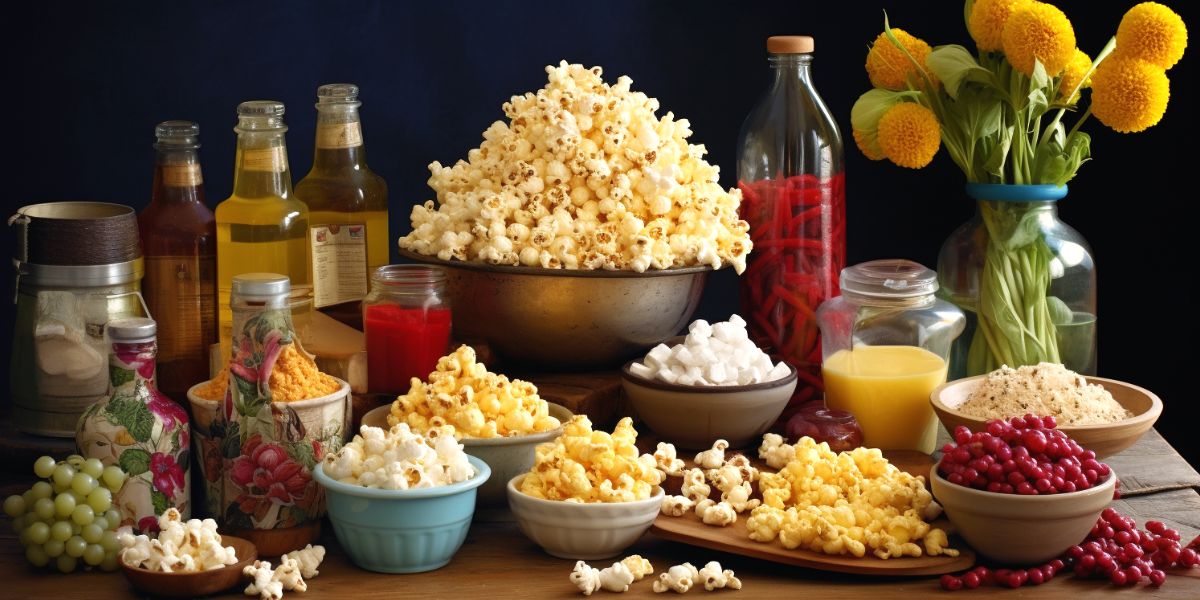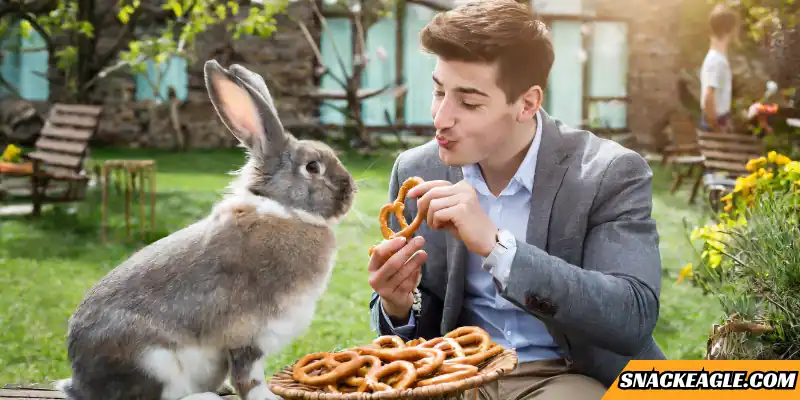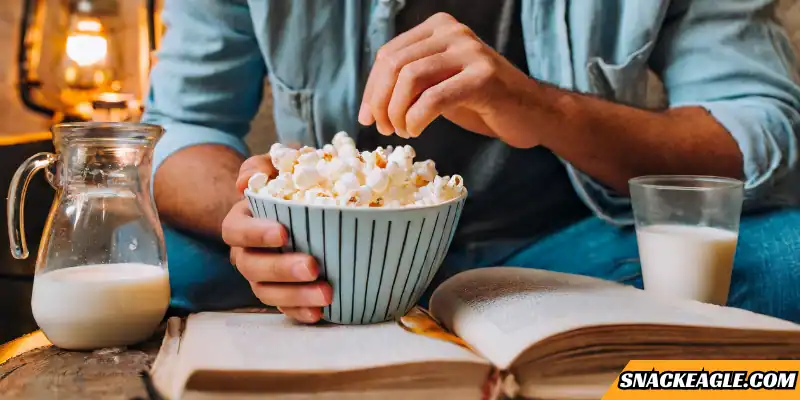Do you love popcorn? We love popcorn! Let’s talk about America’s favorite snack; popcorn!
Popcorn is the most frequently consumed snack food in the United States. The average American eats 50 quarts of popcorn per year, and over 80% of households buy it regularly.
For thousands of years, we have enjoyed this simple, tasty snack, and because we’re so passionate about popcorn, we made this the ultimate guide to leave no question unanswered about this fluffy, delicious snack.
What is Popcorn?
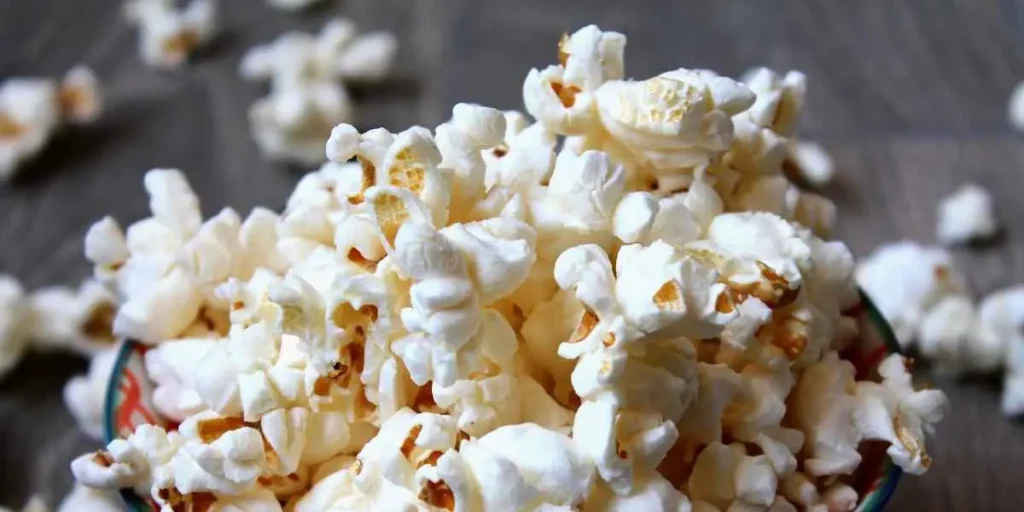
Popcorn (or Zea mays everta) is both the type of corn and the name of our favorite snack.
Popcorn is a whole-grain food that is full of fiber, vitamins, and minerals, not only a great source of antioxidants, but popcorn also contains many different nutrients that are good for your health.
There are many types of popcorn available in stores, including microwave popcorn, organic popcorn and regular popcorn. They all have their own unique taste and texture. You can even make your own popcorn at home using an air popper or stovetop method.
Popcorn is made from corn kernels that have been heated until they pop open and explode into tiny pieces of starch. These pieces are then dried out so they can be eaten as a snack or as part of another meal (such as with milk).
History of Popcorn
Who First Ate Popcorn?
In 2012 archeologists made some exciting popcorn-related finds as they unearthed evidence that 6700 years ago they were popping corn into popcorn in Peru.
The oldest American popcorn was found in New Mexico and dates back to about 3,000 years ago. It’s believed that Native Americans first discovered popcorn by accident when their dried corn kernels exploded while cooking over an open fire.
The Aztecs made popcorn balls called “tlacoyos” which they filled with honey or ground pumpkin seeds and ate during religious ceremonies. They also used popcorn as decoration on their headdresses and clothing.
Early American colonists brought popcorn to Europe, where it quickly became a popular snack at fairs and carnivals. According to legend, the first person to eat popcorn in Europe was King Louis XIV of France (1638-1715).
He had been given a gift of popcorn by his ambassador to Canada and asked his chef de cuisine to prepare it for him as a treat. The chef thought the kernels were corn nuts and cooked them with peas. When he presented the dish to the king, he was horrified by what he saw: kernels stuck together in clumps that looked like old horse manure!
However, it wasn’t until 1864 that popcorn began being sold commercially in the United States.
Popcorn is still popular today, especially at movie theaters and sporting events where people enjoy it while watching a film or sporting event.
Where Does Popcorn Come From?
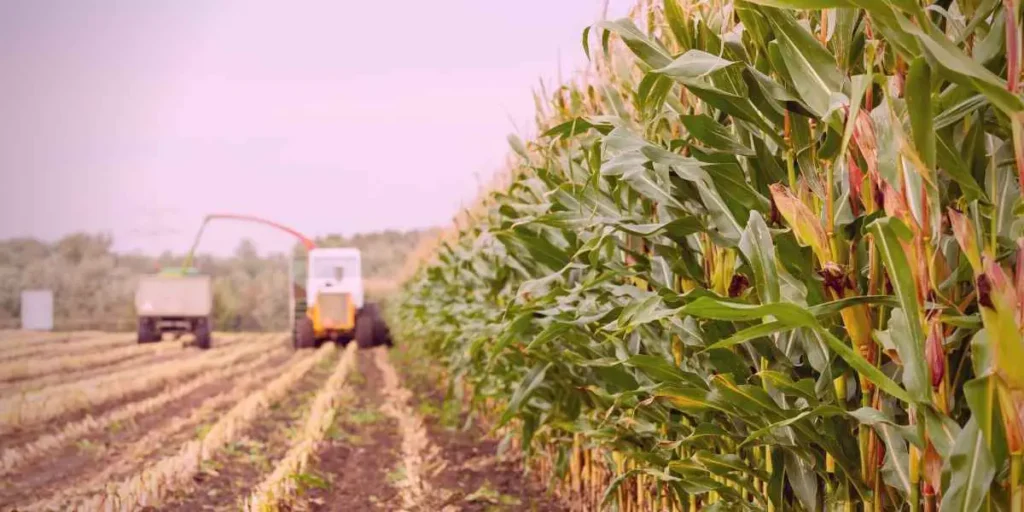
The word “popcorn” dates back to 1680 in England, where it was used to describe a variety of small, hard seedpods that would explode when heated. The current term “popcorn” didn’t appear until 1777 in America, when colonists first began growing corn on a large scale.
Today popcorn is grown mostly in the USA, and there are a whopping 25 US States currently farming popcorn. The USDA reports that Nebraska currently produces over one-quarter of all popcorn with the other largest production states being:
Nutritional Information
What Food Group is Popcorn?
Popcorn is a whole grain and falls under the starchy vegetable category in the USDA food pyramid.
It is also considered a whole grain because it has all three parts of the grain — the hull (the outer layer), endosperm (the inner layer), and germ (the part that grows into a new plant).
What Is Popcorn Made of?
| Carbohydrates | 76% |
| Protein | 12% |
| Water | 4% |
| Fat | 4% |
Energy Values/ Calories of Popcorn (Per 100 Grams)
| Energy Kilojoules | 1598 kJ |
| Calories | 382 kCal |
* Note that all values are taken as plain popcorn without oil, butter, or toppings.
The number of calories does vary considerably depending on how you pop your popcorn and the toppings it’s coated in. Check out the number of calories in your popcorn by using our popcorn calorie calculator.
How Does Corn Become Popcorn?
Popcorn is a type of corn that pops when heated. The popcorn kernel contains a small pocket of water, which turns to steam when heated. The steam builds pressure inside the kernel until the kernel explodes open, breaking the hull and releasing the popcorn.
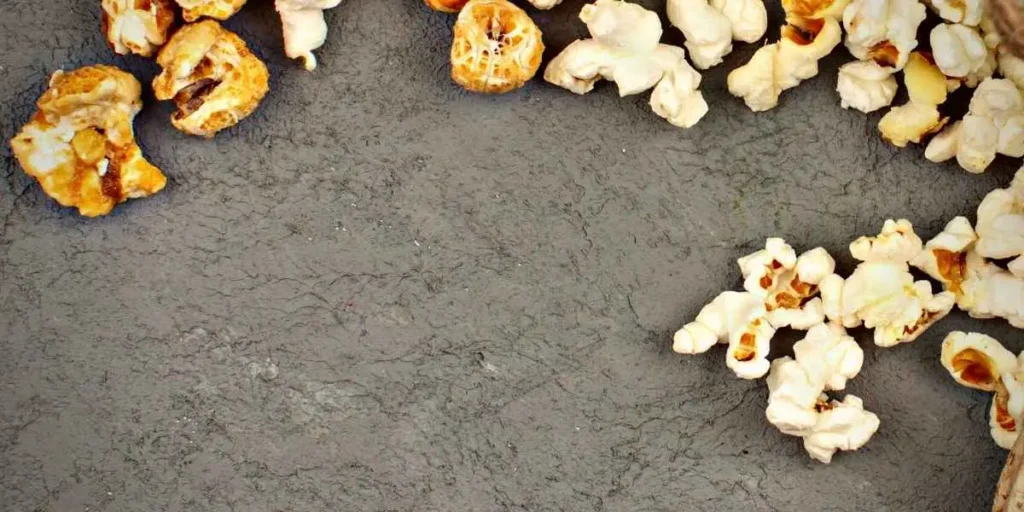
The process of turning corn into popcorn is quite simple. First, the kernels are heated in a large pan or kettle with oil or butter over a burner. Once they begin popping, they are tossed with salt or sugar to add flavor before serving.
What are the Different Types of Popcorn?
There are many varieties of popcorn and each type has its own unique flavor and texture.
There are several types of popcorn:
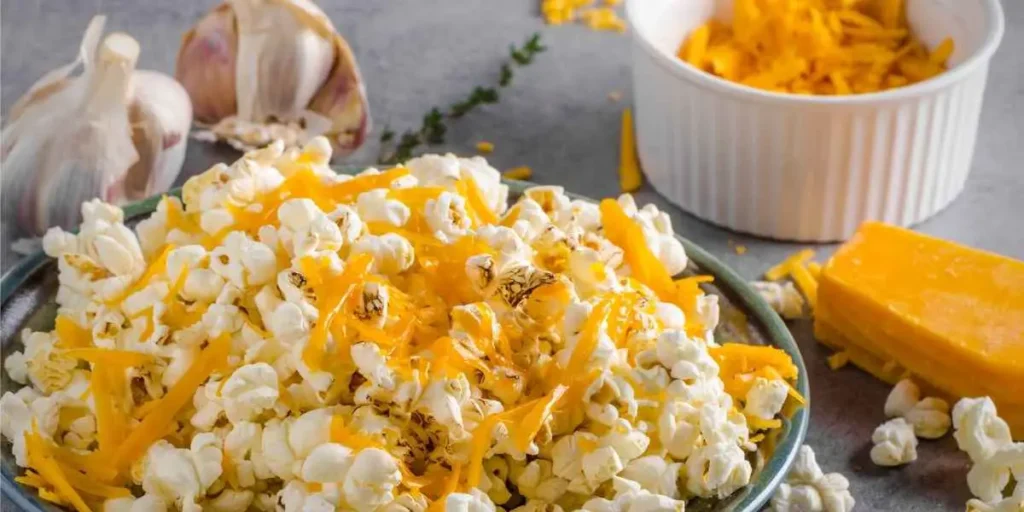
Popcorn can be eaten:
Popcorn Kernel Colors
| Yellow | Common, cheap, nutty flavor |
| White | Mellow flavor best for adding seasoning |
| Red | Tender, light, and nutty flavor |
| Blue | Similar to red but with a unique flavor |
| Purple | Similar to blue but larger kernels |
”Popcorn is a type of flint corn but has its own size, shape, starch level, and moisture content. It has a hard exterior shell and a soft starchy center. When heated, the natural moisture inside the kernel turns to steam and builds up enough pressure to eventually explode. Other types of dried corn may burst open slightly when heated, but popcorn is unique in its taste and popability.” – Popcorn.org
In the corn family, popcorn is a type of flint corn. Other types are sweet corn and dent corn.
What are Some Seasonings That Go Well With Popcorn?
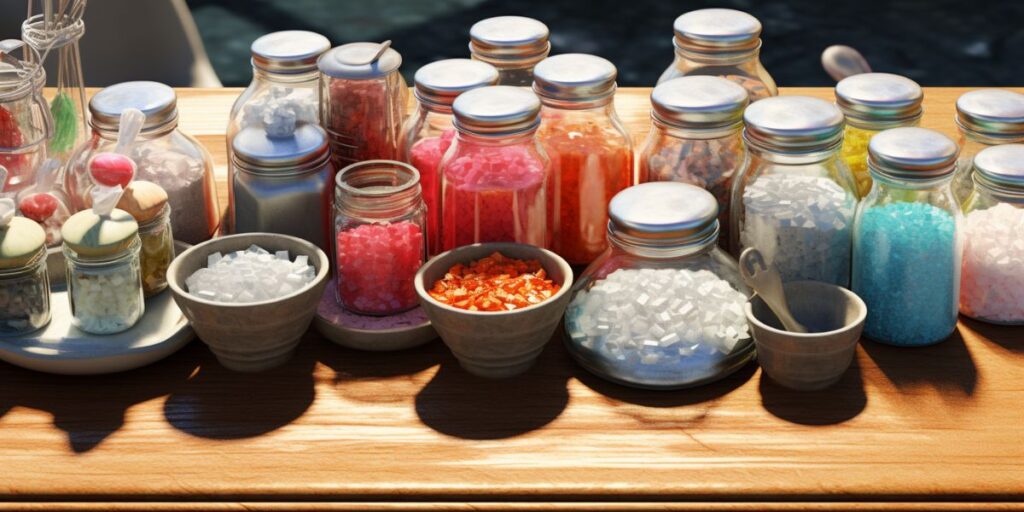
Popcorn is a versatile food, and can be eaten sweet or salty, on its own, or with a variety of toppings and seasonings.
Here are some popular seasonings that go well with popcorn:
What Salt is Best for Popcorn?
If you’re no stranger to a modern kitchen, you’ll know that salt is not just salt these days. From Pink Himalayan to Coarse Sea Salt, there is plenty of variety, and the great news is they all work really well. However, if you are not a huge salt lover, try a finer-grain variety and use it sparingly. That should result in a small amount evenly spread over your popcorn
A few of the various salts to try:
What’s the Most Popular Popcorn Brand?
In 2020 the folks over at Statista Research Department surveyed the American public to find that their most consumed brand of popcorn is Orville Renenbacher’s.
Why Does Movie Theater Popcorn Taste Different?
The main reason movie theater popcorn tastes so good is because of the ingredients used when cooking it – both the type of oil and the flavoring.
Movie theater popcorn is cooked using canola or coconut oil or a combination of both. More expensive than other types of oils, they give movie popcorn its unique flavor and texture. You can also use regular vegetable oil instead — it won’t be quite as good as coconut or canola oil, but it will still make good popcorn.
The flavoring used in movie theater popcorn is called flavacol. It’s a super fine, butter-flavored salt that gives the popcorn that unique taste.
Another reason for the difference in taste is movie theaters use larger kernels than what you find in grocery stores or bulk bins. These larger kernels have more water inside them, which makes them easier to pop into fluffy white pieces when heated with hot air from an industrial popper machine (or stovetop). Smaller kernels are more prone to burning and producing inconsistent batches of popcorn.
What is a Popcorn Garland?
Popcorn garlands are a hot new trend in home decor. They’re super easy to make, they can be made in any size, and they look cute as heck!
A popcorn garland is simply a strand of popped popcorn strung on twine. The popcorn is held together with string or yarn in various patterns, creating a beautiful wall hanging that can be used in any room of your home.
Popcorn garlands can be displayed all year round, but they are especially popular for Christmas and Halloween. They’re also great for parties and special occasions because they add a fun pop of color and texture to any space.
How to Store Popcorn Kernels
To preserve popcorn for as long as possible, store them in an airtight container like Tupperware or glass container with a screw top. This will prevent the kernels being exposed to the air and going stale as quickly.
What Types of Oil to Use to Cook Popcorn?
The best oils for cooking popcorn are:
We have a full article on the best oils to use for popcorn machines; check it out – Perfect Oil for Popcorn Machines.
When is National Popcorn Day?
National Popcorn day is January 19th.
FAQs About Popcorn
What makes popcorn pop?
Popcorn pops due to the moisture inside the kernel. When heated, the moisture turns into steam, creating pressure within the kernel until it eventually explodes.
Is popcorn a healthy snack?
Yes, popcorn is considered a healthy snack. It is a whole grain, high in fiber, and contains beneficial nutrients. However, the healthiness can be affected by toppings and preparation methods.
How many calories are in popcorn?
The number of calories in popcorn can vary based on preparation and toppings. Plain, air-popped popcorn has approximately 30 calories per cup, but buttered or flavored popcorn can have significantly more.
Can popcorn be gluten-free?
Yes, popcorn is naturally gluten-free. However, flavored popcorn or those with added ingredients may contain gluten, so it’s important to check the labels for gluten-free certification.
Can popcorn be a choking hazard?
Popcorn can be a choking hazard, especially for young children. It’s important to supervise them while eating popcorn and ensure the pieces are small and easily chewable.
Is microwave popcorn safe to eat?
Microwave popcorn is safe to eat when prepared according to the instructions. However, some concerns have been raised about the chemicals used in microwave popcorn bags, so air-popping or stove-popping methods are alternative options.
Can popcorn help with weight loss?
Popcorn can be a helpful snack for weight loss due to its low calorie and high fiber content. However, portion control and avoiding excessive butter or sugary toppings are essential for weight management.
Does popcorn have any nutritional value?
Yes, popcorn has nutritional value. It is a good source of fiber, contains vitamins and minerals, and is low in fat (without added toppings). However, the nutritional value can vary depending on the type and preparation.
Can popcorn cause digestive issues?
In general, popcorn is well-tolerated by most people. However, some individuals may experience digestive discomfort due to its high fiber content. It’s important to listen to your body and consume popcorn in moderation.
How should I store popcorn to keep it fresh?
To keep popcorn fresh, store it in an airtight container or resealable bag in a cool, dry place. This helps prevent moisture absorption and maintains its crispness.
Can I make popcorn without oil?
Yes, you can make popcorn without oil. Air-poppers or microwave popcorn poppers designed for oil-free popping are available. Stove-popping with minimal oil or using a hot air popcorn popper are other options.
Can I pop regular corn kernels instead of using popcorn?
Regular corn kernels are not suitable for popping into fluffy popcorn. Popcorn kernels have a specific moisture content and structure that allows them to pop, while regular corn kernels are typically used for other culinary purposes.
Is it safe to eat popcorn every day?
While popcorn can be a healthy snack, consuming it in moderation is recommended. It’s important to maintain a balanced diet and not rely solely on popcorn as a daily food source.
Can I reheat leftover popcorn?
It is possible to reheat leftover popcorn, but it may lose its crispness. The best way to reheat is to spread it on a baking sheet and warm it in the oven at a low temperature for a short time.
Can popcorn go bad?
Popcorn has a long shelf life if stored properly. However, like any food, it can go bad over time. Check for signs of spoilage such as mold, strange odors, or a rancid taste before consuming.
Get Popping! 💭
Popcorn is an old favorite, and no matter what type you prefer (air-popped, stove-popped, microwave, or make your own gourmet), everyone loves it.
So for anyone new to the popcorn scene, welcome! Popcorn is a food that will never be going out of style; it’s been around for thousands of years and we hope it’s with us for thousands more.
So for anyone new to the popcorn scene, welcome! Popcorn is a food that will never be going out of style; it’s been around for thousands of years and we hope it’s with us for thousands more.
We hope you love our popcorn-devoted website as much as we have creating it! Stay and have a look around!

